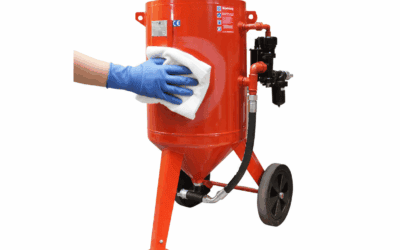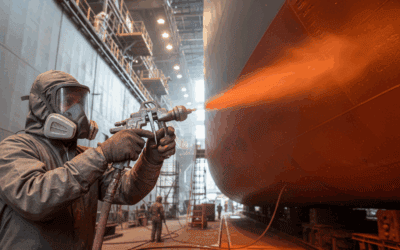Abrasive blasting for marine applications: Challenges and best practices
Marine structures face relentless environmental pressures.
Saltwater, high humidity, and continuous exposure to the elements accelerate corrosion and wear on surfaces. Effective surface preparation is essential to ensure the durability of vessels, offshore platforms, and port infrastructure. Abrasive blasting for marine applications plays a vital role in removing rust, scale, and coatings – but it comes with specific challenges that require thoughtful solutions. In this blog, we explore the main hurdles in marine surface preparation and share proven best practices to help ensure successful outcomes.
The challenges of abrasive blasting in marine environments
- Corrosive conditions: Saltwater is highly corrosive, and marine equipment is often subjected to constant moisture, salt spray, and biological fouling. Surfaces can begin to oxidise almost immediately after blasting if they aren’t properly managed, making timing and technique critical.
- Difficult access and confined spaces: Ships and offshore platforms often contain tight or irregular spaces – ballast tanks, bilges, and structural recesses – that are difficult to access with conventional blasting equipment. This increases the complexity of surface preparation and can impact the quality of the finish.
- Environmental regulations: Marine abrasive blasting must adhere to strict environmental regulations to avoid contaminating surrounding waters with debris or harmful materials. This includes managing spent abrasive, capturing airborne dust, and preventing overspray.
- Surface cleanliness standards: Marine coating systems often require surfaces to be prepared to very high standards (e.g., SA 2½ or SA 3). Achieving this in humid or damp conditions adds another layer of difficulty, particularly on active vessels or in tidal areas.
- Operational limitations: In many marine projects, abrasive blasting must be performed during tight maintenance windows – either in drydock or during planned downtime offshore. This places added pressure on teams to work quickly without compromising quality or safety.
Best practices for effective marine surface preparation
To ensure successful outcomes in blasting for ships and offshore structures, it’s essential to follow industry best practices.
Here are some key recommendations:
- Choose the right abrasive: Select abrasives that provide consistent performance in marine settings. Common choices include garnet, aluminium oxide, and steel grit – each offering different levels of aggressiveness, recyclability, and surface profile control. For offshore abrasive blasting, low-dust and non-toxic options are often preferred.
- Control environmental conditions: Blasting should be carried out in dry, controlled environments wherever possible. Use dehumidifiers or temporary enclosures to reduce moisture levels and delay flash rusting. In high-humidity conditions, immediate priming after blasting is often essential to protect exposed steel.
- Use equipment suited to the application: Compact, manoeuvrable blast equipment is vital for working in confined spaces. Remote-control blast systems, robotic blasting units, or sponge blasting technology can improve access and reduce dust in sensitive environments.
- Implement containment and waste control: Install proper containment systems to prevent blast media, coatings, and rust particles from entering the marine environment. This might include tarpaulin sheeting, vacuum recovery systems, and filtration units. Ensure waste is collected and disposed of in compliance with local regulations, such as MARPOL guidelines or national marine protection laws.
- Train operators to marine standards: Blasting teams should be trained specifically for marine surface preparation and familiar with the challenges of offshore work. Understanding how to work safely in high-risk environments, handle specialist equipment, and meet tight tolerances is crucial for success.
- Coordinate closely with coating teams: Surface preparation and coating application must be closely coordinated to prevent rework and ensure long-term protection. Communication is key – ensure that the blasted surface is inspected and approved before moving on to the next stage of marine coating prep.
Key takeaways
- Select abrasives that suit the marine environment and surface requirements.
- Use containment systems and comply with environmental regulations.
- Minimise humidity and protect freshly blasted surfaces from flash rusting.
- Choose equipment that works in tight, confined areas.
- Train operators to handle the unique risks of marine work.
- Align blasting and coating processes to ensure long-lasting results.
Conclusion
Abrasive blasting for marine applications is complex, highly regulated, and often time-sensitive. But with the right equipment, training, and environmental controls, marine assets can be effectively prepared and protected against corrosion.
Whether blasting a hull in drydock or preparing offshore structures in harsh conditions, best practices help ensure a safer, more efficient process and a durable, compliant finish.
You can visit our website to discover our blasting and coating solutions for the marine industry.



